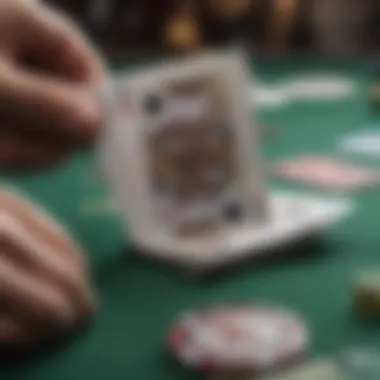Mastering the Essentials of Three Card Poker


Intro
Three Card Poker has carved its niche in the realm of casino games thanks to its blend of simplicity and strategic depth. Its appeal spans from casual gamblers to seasoned poker aficionados, each drawn in by the allure of quick rounds and engaging play. As the name suggests, players engage with just three cards, but beneath this surface lies a rich tapestry of rules and strategies that can make or break a session at the table.
In this article, we peel back the layers of Three Card Poker, elucidating the rules that govern gameplay, examining the multifaceted betting options, and discussing strategies for players of all skill levels. Understanding these intricacies not only enhances enjoyment but can significantly affect outcomes at the felt.
Strategies and Tips
Beginner Guides
For those dipping their toes into the waters of Three Card Poker, grasping the basics is essential. The game centers around the concept of making the best possible three-card hand. The fundamental hand rankings closely mirror traditional poker, with straight flushes topping the list, followed by three-of-a-kinds and flushes, amongst others.
To start with:
- Familiarize Yourself with Hand Rankings: Knowing what beats what is first and foremost. Often, new players overlook the strength of their hands.
- Understand the Betting Options: Before you place your chips, it’s crucial to know the difference between the ante, which is the initial bet to play, and the Pair Plus bet, which gives you a chance to win based on the strength of your hand alone.
- Play Responsibly: Set a budget and stick to it. It’s easy to get swept away in the thrill of the game, but a considered approach keeps the fun alive without the stress of overspending.
Advanced Techniques
Once you've grasped the essentials, stepping into more advanced strategies becomes possible. Here, we call attention to nuanced tactics that can offer a competitive edge:
- Strategic Folding and Betting: Knowing when to play and when to fold is pivotal. Many players tend to get attached to weak hands. A general guideline is to play with a hand of queen-six-four or better. If your hand falls short, it’s often wise to bow out.
- Read the Table: Watch how other players behave. Although Three Card Poker primarily revolves around your hand, understanding others can offer insights into potential betting patterns.
- Utilize Optimal Betting Patterns: Aquaint yourself with the concept of optimal strategies, which can lessen the casino’s edge and improve your odds over time.
"Mastering the art of betting in Three Card Poker isn’t just luck; it’s about awareness of your hands, table dynamics, and strategic betting."
Game Insights
Game Reviews
Feedback from players often highlights the dynamic nature of Three Card Poker, with various adaptations making their way into online and brick-and-mortar casinos alike. For instance, some establishments offer a progressive jackpot, adding an enticing twist. Review platforms like Reddit feature real player experiences, making them invaluable for anyone looking to learn more about the game's landscape.
Trends in Gambling
The world of gambling is constantly evolving. Recently, Three Card Poker has seen a resurgence in interest as a fast-paced alternative to traditional poker games. As live tournaments and online platforms grow, they weave this game into the latest trends in gaming. Enthusiasts are increasingly blending poker strategies with general betting concepts, making it easier to maximize winning potential across various games.
Prologue to Three Card Poker
Three Card Poker stands firmly as a prominent fixture in the landscape of casino gaming. The simple elegance of the game, combined with its often underappreciated depth, invites players of various skill levels to partake. Understanding its mechanics, nuances, and strategies can help enhance one's gambling experience, making learning about it crucial for enthusiasts. Whether you're dipping your toes into the water or diving headfirst, mastering Three Card Poker can elevate your gameplay significantly.
Players are often drawn to Three Card Poker for its straightforward nature while still encapsulating the thrill that comes with traditional poker. The appeal lies in its blend of luck and strategic decision-making; knowing when to place bets, and how to navigate the betting landscape can indeed affect your outcomes. Many visitors in casinos see it as a sure way to have fun, but a solid understanding of its underlying rules has the potential to boost the enjoyment further.
Benefits of Learning Three Card Poker
- Familiarity with Rules: Knowing the rules means you won’t be left out when friends or fellow gamblers engage in discussions about the game.
- Enhanced Decision-Making: Grasping the strategies gives players confidence – no one likes second-guessing their actions while in the heat of the moment.
- Financial Management: Understanding the various betting options helps in managing your bankroll, keeping you in the game longer.
- Networking Opportunities: Engaging with other players who share an interest can lead to lasting friendships or alliances in the gaming community.
It's not just about throwing cards on the table – it's about navigating the intricacies of decision-making under uncertain conditions. This section sets the stage for a richer understanding of Three Card Poker, leading into its fascinating history and popularity in the gaming world.
Brief History of Three Card Poker
Three Card Poker made its debut in the early '90s, crafted by a casino entrepreneur named Derek Webb. His innovation allowed players to experience a variant of the traditional poker game focusing on speed and excitement, cutting out the protracted duration commonly associated with other poker games. The game was licensed and distributed broadly, especially thriving in casinos throughout the United States and eventually spreading across the globe.
Webb's unique creation not only included standard poker rules but also offered players additional betting options such as the Pair Plus bet, which was quite innovative at the time. This aspect appealed to many; it was a game that didn't require extensive poker knowledge while still captivating seasoned players. Over the years, expansion into online platforms led to an increased interest and facilitated the expansion of Three Card Poker’s audience.
Why Three Card Poker is Popular
The popularity of Three Card Poker can be attributed to several engaging factors that set it apart in the vast world of table games.
- Accessibility: The game doesn’t require a deep understanding of poker mechanics. This attracts casual players who might otherwise shy away from traditional poker tables.
- Fast-Paced Play: Each hand takes relatively little time, keeping players engaged and circuits running at a lively pace. Players can make swift decisions, contributing to a pulse-pounding gaming environment.
- Social Interaction: Whether one plays in a bustling casino or on an online platform, the communal aspect of the game fosters friendly competition. Players enjoy the shared experience, often swapping stories or strategies between hands.
- Low House Edge: Compared to numerous other casino games, Three Card Poker offers a lower house advantage, thus presenting more favorable odds for players willing to learn and fine-tune their strategies.
In summary, the journey from the inception of Three Card Poker to its current status reflects its clever design and player-centric approach. It stands as a testament to how innovation in game mechanics can resonate with players across various backgrounds and preferences. This foundational understanding of both its history and popularity underlines the discussion points that follow in this article.
Game Overview


When stepping into the lively world of Three Card Poker, understanding the foundational elements of the game is paramount. A clear grasp of the game overview not only sets the stage for a more engaged play but also enhances strategic decision-making as you navigate through your casino experience. Knowing how the game works boosts your confidence at the table and can tremendously influence your approach to betting.
Basic Gameplay Mechanics
Three Card Poker is built around straightforward mechanics that appeal both to experienced gamblers and novices alike. The game usually includes a standard deck of 52 cards and takes place between the player and the dealer, rather than between multiple players. To start, players place their bets, typically in the form of an ante, before any cards are dealt. This initial bet is a prerequisite for being in the game.
Upon placing the ante, each player is dealt three cards face down, while the dealer receives three cards face up. The moment the cards are out on the table, it’s time for players to decide if they want to continue in the game. They can either call, matching their bet, or fold, surrendering their ante for the hand. The simplicity of this format emphasizes a swift pace of play, making it appealing for those who enjoy action without excessive nuances.
The hands are evaluated based on standard poker rankings that include straights, flushes, and pairs, among other combinations. A crucial point to note is that players compete only against the dealer and not against each other, which means that the essence of solo strategy becomes more prominent. The result? A thrilling mix of tactics and psychological pressure as players weigh their options with every dealt card.
Objective of the Game
At its core, the objective of Three Card Poker is rather simple: beat the dealer's hand. The player simply aims to form a better hand than what the dealer presents. If a player’s hand beats the dealer's, they win even money on their ante or may receive additional payouts on any optional bets made, like the Pair Plus bet. If the dealer has a better hand, well, then the ante and any additional wagers get collected back into the house's coffers.
But there's more than just winning at play here. Players must also keep in mind the dealer's qualifications. The dealer must have at least a queen high to qualify for the hand. If the dealer fails to meet this requirement, players who called win their ante back, though they lose any additional bets made. This layer of complexity enhances the strategy involved.
In essence, the goal is not just about beating the dealer but also about making calculated betting decisions based on your hand strength compared to the dealer's qualifications. Understanding this objective can sharpen your play style tremendously and add a new level of engrossment to your gaming experience.
Rules of Three Card Poker
In the realm of casino games, the rules governing Three Card Poker hold particular significance. They are not merely a set of guidelines; they are the backbone that frames the entire experience. Understanding these rules can significantly enhance how a player engages with the game. Players who grasp the rules possess an edge in strategy and betting decisions, potentially leading to more favorable outcomes. Moreover, awareness of various plays can inform one’s approach, transforming a casual experience into a more calculated endeavor.
Standard Hand Rankings
When it comes to poker, hand rankings are everything. In Three Card Poker, it’s no different. The hand rankings may seem a bit condensed when compared to traditional poker, but each combination offers its unique nuances. Here’s how they stack up:
- Straight Flush - Three cards of the same suit in consecutive order.
- Three of a Kind - Three cards of the same rank.
- Straight - Three cards in consecutive order, but not of the same suit.
- Flush - Three cards of the same suit, regardless of order.
- Pair - Two cards of the same rank plus one unrelated card.
- High Card - When none of the above combinations are met, the highest card wins.
Understanding these rankings isn’t just about memorization; it informs decision-making when placing bets and analyzing hands against the dealer’s shown card.
The Ante and Pair Plus Bets
Two primary betting options exist in Three Card Poker: the Ante and the Pair Plus bets. The Ante is a standard bet placed before cards are dealt, which advances the game to the showdown phase. It acts as the entry fee to the game and is typically the first wager a player makes.
On the other hand, the Pair Plus bet is slightly more mercurial. It pays out based on the strength of a player's hand, irrespective of the dealer’s hand. This bet adds an additional layer of excitement. Many players find this wager appealing as it combines risk with the potential for a big payoff.
Play Bet and Dealer’s Qualification
After the initial bets are placed and hands are revealed, the dealer's qualifications come into play. A dealer must have at least a Queen high to qualify for the round. If the dealer fails to meet this qualification, the Ante bet is returned to the player. In this scenario, the Play bet remains active, based on the player’s hand:
- Player wins if the dealer does not qualify.
- If both the dealer and the player have valid hands, the winner is determined by traditional ranking rules.
This aspect of dealer qualifications significantly impacts player strategies. Knowing when to play, fold, or simply rely on the Ante can be a game changer in your gambling approach.
Instructions for Dealing Cards
Now let’s discuss how to deal the cards — a seemingly straightforward task, yet one rich with significance. The dealer shuffles the deck thoroughly before cutting it, ensuring pure randomness.
- Each player, along with the dealer, receives three cards, all face down.
- After allowing time for players to evaluate their hands, the dealer turns over their own card.
- Players then decide to either fold or make the Play bet, equal to the Ante wager.
Attention to detail in this process is vital, as errors or slips in dealing can lead to confusion and disputes. Tracking betting patterns, understanding the combination of cards across the table, and observing your opponents’ reactions also contribute to a more informed game.
The inner workings of Three Card Poker blend chance and skill, placing a premium on understanding the rules and how they interplay with strategic decisions.
Betting Options
Betting in Three Card Poker is not just about placing your chips down on the table; it encompasses a variety of strategic choices that can significantly impact your overall success at the game. Understanding these betting options is crucial for anyone looking to elevate their gameplay experience.
When engaging with Three Card Poker, players are presented with several avenues for their wagers. The two primary types of bets are the Ante and the Pair Plus, each offering its own set of risks and rewards. Choosing the right bet can shape your decisions and strategies throughout the game.
Understanding the Ante and Pair Plus Bets


The Ante bet is the initial wager that players make before any cards are dealt. This bet is required to participate in the game, creating a pot that players aim to win. Meanwhile, the Pair Plus bet is an optional wager, allowing players to bet on the strength of their hand alone, regardless of the dealer’s cards.
Here’s a closer look at each:
- Ante Bet:
- Pair Plus Bet:
- This is your ticket to play. It sets the stage and gets the game rolling. Without this bet, you won’t even have a seat at the table.
- Winning with an Ante bet hinges on the dealer qualifying, which means they need at least a Queen high to even consider your bet. If the dealer falls short, your Ante is paid at even money.
- Designed for those who like to take chances, this bet pays based on the hand you receive. Even if the dealer doesn't qualify, you're still in the running for a payout based on your three-card hand ranking.
- The payouts for the Pair Plus can be lucrative. For instance, a Straight Flush might pay out 40 to 1, making it an exciting risk for players hoping for a lucky hand.
In summary, understanding the difference between these two bets empowers players to make informed choices. As basic as they might sound, selecting between an Ante or Pair Plus can entail deeper strategic considerations.
Exploring Additional Wagering Opportunities
Beyond the Ante and Pair Plus bets, Three Card Poker offers players further ways to emphasize their gameplay through various additional bets.
Some notable options include:
- Bonus Bets:
- Side Bets:
- Some casinos introduce specific bonus bets that enhance the excitement and potential winnings. These can often depend on certain hand combinations, providing additional layers of strategy to consider.
- Players might encounter one or two side bets, which allow for more chances to win. These bets can correlate with special hands, inviting those willing to take a leap. Such side bets usually offer higher payouts but come with keen risks.
It's important to remember that each of these options can drastically change the dynamics at the table. Players must assess their risk tolerance, considering how additional wagers may affect their overall bankroll management.
In the world of Three Card Poker, better understanding the betting options can serve as a roadmap through its intricacies, leading players closer to informed and strategic decisions.
Strategic Considerations
When it comes to Three Card Poker, having an understanding of strategic considerations can prove to be the difference between walking away with a fat wallet or empty hands. Strategy in this game is not solely about luck; it involves a blend of informed decision-making and psychological insights. Players who delve into strategic approaches can enhance their gameplay significantly, leading to improved winning chances and a deeper appreciation of the game.
Basic Strategies for Beginners
For newcomers, the learning curve can seem steep, but a few basic strategies can simplify the gaming experience. Here’s what novices should keep in mind:
- Play Strong Hands: As a beginner, it might be tempting to play hands even if they don't look good. However, it's better to fold unless you have a hand like a Queen-6-4 or better. This will prevent unnecessary losses.
- Understand Betting Options: Familiarize yourself with the different types of bets - Ante and Pair Plus. This knowledge will help you determine when to take risks and when to play it safe.
- Practice Makes Perfect: Hit the practice tables or online games. This is a low-pressure way to understand the flow of the game without the risk of real money.
By focusing on these basic strategies, beginners can build a solid foundation while gaining confidence in their gameplay.
Advanced Techniques for Experienced Players
Once you’ve got the basics down, it’s time to step into the deep end of the pool. Advanced players can truly octane their game by employing some subtler techniques:
- Card Counting: While more common in traditional poker formats, keeping track of the high cards dealt can offer insight into the remaining deck.
- Adjusting Your Bets: Advanced players will sometimes alter their betting patterns based on their read of the table and other players. A larger bet when holding a strong hand can put pressure on opponents, while smaller bets can induce them to stay in with weaker hands.
- Psychological Play: Reading your opponents goes a long way. Observe their betting patterns and facial expressions. A stiff player typically has a strong hand, while a relaxed attitude might indicate bluffing.
Such strategies can create opportunities to exploit opponents, thus gaining a tactical advantage.
Psychology of Betting Decisions
Betting decisions aren’t made in a vacuum; they are influenced by the psychological state of the player and their perception of other players. Understanding this aspect can elevate a player’s game significantly. Here are some nuances to consider:
- Cognitive Biases: Players may fall prey to biases like loss aversion, leading them to risk more after a loss in hopes of recovery. Recognizing these patterns in oneself can lead to better decisions.
- Emotional States: Feelings like excitement or frustration can cloud judgment. A player on a winning streak might overestimate their capabilities, while a losing player might become overly cautious. Staying level-headed can improve outcomes.
- Table Dynamics: The collective mood at the table can affect individual decisions. If the atmosphere is tense, players might be more prone to conservatism, while a light environment may encourage risk-taking. Adapt your strategy to the mood of the table for optimal results.
"Understanding the psychology of your own decisions and those of your opponents can turn the tide of the game in your favor."
Variations of Three Card Poker
Understanding the Variations of Three Card Poker is key for any serious player looking to enhance their game. Variants can add unique twists, strategies, and potential payoffs that keep the experience fresh and engaging. Knowing these variations and their intricacies allows players to broaden their skill set and adapt to different gaming environments, whether at a bustling casino or a friendly home game.
Common Game Variants


There are several notable variants of Three Card Poker that have gained traction among players. Each version brings something different to the table, allowing one to find a style that suits their approach.
- Progressive Three Card Poker: One of the more popular variants, this version includes a progressive jackpot that increases with each round until someone wins it. Players can place an additional bet to participate in the jackpot, making every game a bit more thrilling.
- Three Card Poker Switch: In this variant, players are allowed to switch one of their cards with one from the dealer’s pile after reviewing their hands. This added layer of strategy can make all the difference, allowing a player to strengthen their hand and increase their chances of winning.
- Ultimate Texas Hold'em: While branching away slightly from traditional Three Card Poker, this variant incorporates elements of Texas Hold'em with a Three Card Poker twist. Players make the same decisions as in Texas Hold'em, with the addition of the initial Three Card Poker hand that influences their strategy.
Being familiar with each of these options can elevate a players' ability to adapt and explore new strategies based on variant-specific rules.
Rules Specific to Variants
Each variant of Three Card Poker contains its own set of rules and strategies. Knowledge of these rules is crucial for maximizing potential wins and enjoying gameplay. Here are some key ones:
Progressive Three Card Poker
- Jackpot Initialization: Before anything else, players need to place a separate wager to enter the jackpot. This bet is independent of the standard ante or play bets.
- Winning the Jackpot: To win, a player needs to achieve a certain hand—usually a straight flush or better. Details on the winning hands and associated payouts can vary from casino to casino, so it's wise to check the specific rules before playing.
Three Card Poker Switch
- Hand Switching Mechanics: Players can swap out one of their cards for a new one which adds randomness to the outcome. The switch can sometimes mean the difference between winning and losing.
- Winning Conditions: The player must still have the best hand against the dealer, so strategic thinking must still apply even with the chance to switch cards.
Ultimate Texas Hold'em
- Strategic Bet Decisions: Players must place both an ante and a play bet, just like in traditional Texas Hold'em. This means early game decisions impact outcomes later on, making tactical play a must.
- Community Cards: Players incorporate community cards in this version, which requires a different mindset compared to standard Three Card Poker.
Incorporating various game variants into your repertoire allows you to grow and adapt your strategies. It’s about embracing the differences that make Three Card Poker engaging and dynamic, no matter where you play.
Cultural Significance of Three Card Poker
Three Card Poker is not just another game on the casino floor; it carries weight in various aspects of popular culture and social interactions. Its significance goes beyond mere entertainment. Players engage in a complex interplay of strategy, luck, and social dynamics, which resonates in both formal settings and informal gatherings. This section delves into the broader cultural implications of Three Card Poker and why it remains a favorite among many.
Three Card Poker in Popular Culture
Over the years, Three Card Poker has carved its niche in movies, TV shows, and even literature. It’s characteristic simplicity and fast-paced nature make it a natural choice for film scenes depicting casino life. When a character sits down at a Three Card Poker table, it instantly signals a high-stakes scenario, often fraught with tension and emotion.
In some instances, it serves as a plot device to explore themes of chance, risk, and human nature. For example, a character might try their luck in hopes of recovering from a financial mess or seeking redemption. The game reflects the fine line between fortune and misfortune, illustrating how quickly circumstances can change with a single hand of cards.
Additionally, the game has evolved into an online sensation, with various platforms capturing the interest of younger players. This digital divide has expanded its reach, converting casual players into enthusiasts with easy access to gameplay tutorials and virtual casinos.
The representation of Three Card Poker in popular culture underscores its role as not just a game, but a shared experience laden with social significance.
Impact on Casino Entertainment
Three Card Poker holds a significant place in the realm of casino entertainment, making it appealing to both casual players and seasoned gamblers. Its fast-paced nature attracts those who prefer swift gameplay—keeping things lively without excessive downtime. This is crucial in a bustling casino environment where players are frequently in search of new thrills.
There are several reasons why it has become a staple in casinos across the globe:
- Accessible Gameplay: Unlike traditional Poker variants that require extensive knowledge of strategies, Three Card Poker is simple to learn. New players can quickly grasp the rules and feel comfortable at the table.
- Diverse Betting Options: Players have various betting avenues, including the Ante and Pair Plus, which adds to the excitement and allows for varied strategies.
- Social Interaction: The game facilitates social engagement amongst players. Laughs, cheers, and even friendly ribbing create a lively atmosphere. This camaraderie enhances the enjoyment level, encouraging repeat visits.
- Spectacle of Strategy vs. Luck: The dynamic between calculated decisions and the game's inherent randomness creates a spectacle—players revel in the tension of waiting to see if they’ll land that winning hand.
The continued popularity of Three Card Poker reinforces its dominant position in the casino landscape, ensuring it remains a favored choice for players looking for relatable and engaging gaming experiences.
Closure
Three Card Poker, with its blend of ease and excitement, holds a special place in the hearts of many casino goers. The conclusion of this article centers on the significance of understanding the nuances of this game. One cannot simply approach it without a grasp of its structure, rules, and the strategic depth it offers.
In summary, the rules of Three Card Poker are not merely a checklist; they form the backbone of the game, informing players about how to effectively make their bets, read their hands, and strategize their plays. Recognizing the importance of hand rankings, the intricacies of the Pair Plus and Ante bets, and dealer qualifications are essential steps toward being a competent player.
Summary of Key Points
- Basic Gameplay Mechanics: Players need to know how to initiate a game and the flow of play.
- Hand Rankings and Betting Mechanics: Understanding which hands beat which and the different types of bets is crucial for making informed decisions.
- Strategic Choices: Knowing when to play or fold based on both your hand and the dealer’s qualifications can significantly enhance winning chances.
- Cultural Context: The popularity of Three Card Poker is also tethered to its portrayal in popular culture and its significance in the world of casinos.
These aspects encapsulate the core elements of the game, presenting not just the rules but the importance of strategy, psychology, and culture in the gaming experience.
Final Thoughts on Three Card Poker
As we wrap up this exploration, it's evident that Three Card Poker is more than just a game of chance; it’s a game that rewards knowledge and strategic thinking. From understanding the play dynamics to the emotional undertones of betting, this game offers a rich tapestry for those willing to engage deeply.
Above all, the beauty of Three Card Poker lies in its accessibility. New players can quickly pick up the game while also offering layers of depth for seasoned players seeking to refine their strategies. Each hand dealt is a unique opportunity, and with the right mindset and knowledge, every player can have a thrilling experience at the table.
In the end, whether you’re playing for fun or staking serious cash, embracing the rules and strategies of Three Card Poker will undoubtedly lead to a more rewarding and enriching casino experience. So the next time you sit down at a Three Card Poker table, remember: knowledge is power.







